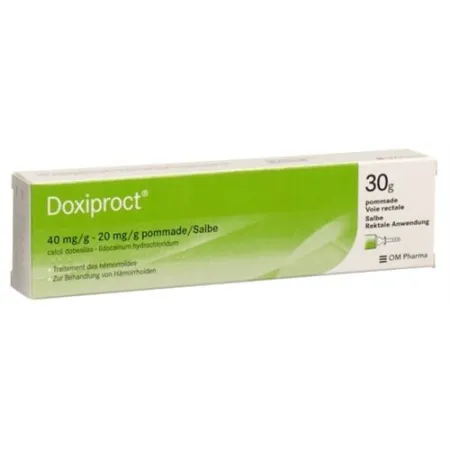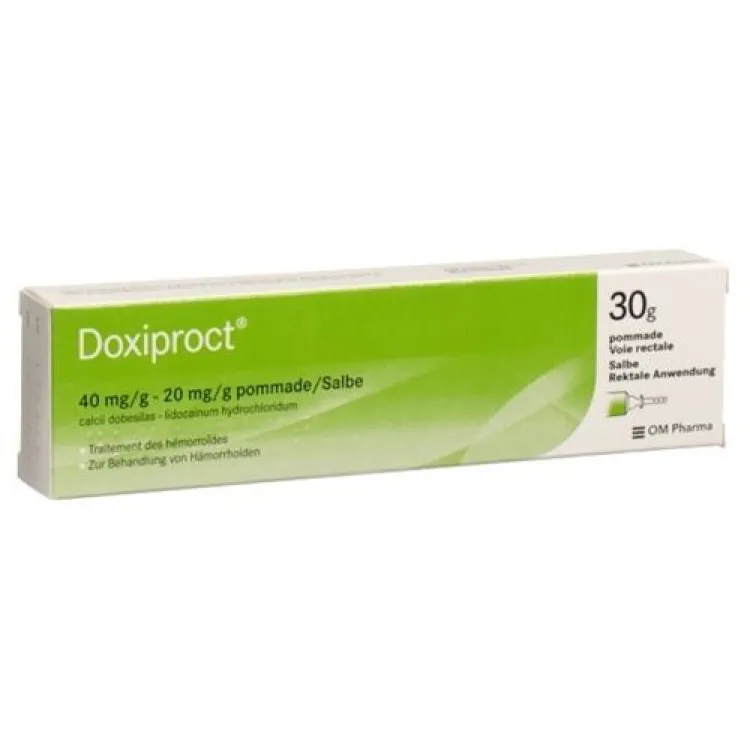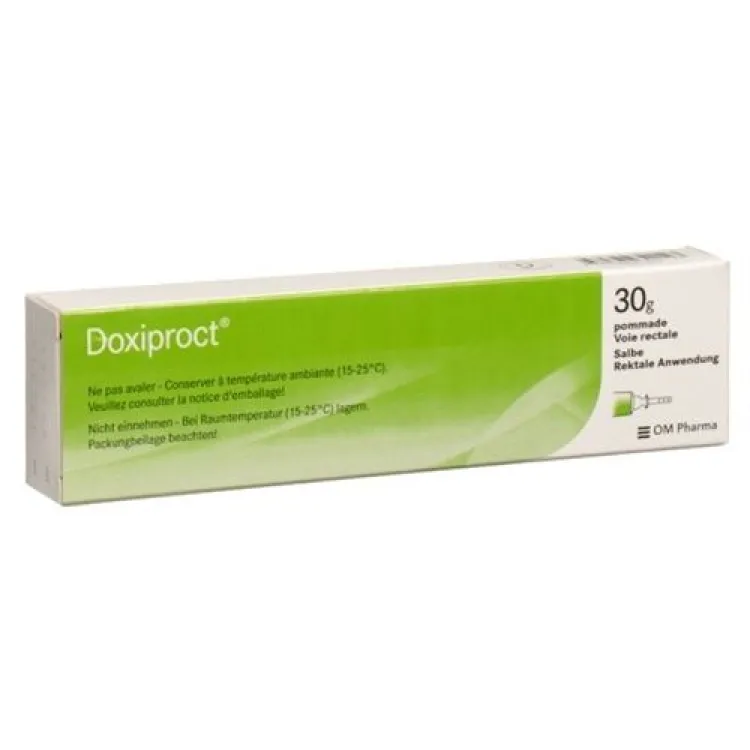Doxiproct Ointment tube 30 g
Doxiproct Salbe Tb 30 g
-
28.85 USD

- Availability: In stock
- Distributor: VIFOR SA
- Brand: Doxiproct
- Product Code: 677659
- ATC-code C05AD01
- EAN 7680389320123
Ingredients:
Description
What is Doxiproct and when is it used?
The Doxiproct rectal ointment contains the following active ingredients: calcium dobesilate, which normalizes the resistance and permeability of the wall of the small blood vessels - the so-called capillaries - and lidocaine, a local pain-relieving agent.
Doxiproct has an anti-inflammatory effect, reduces bleeding and weeping and leads to rapid relief Relief of pain, burning, itching and feeling of tightness in the following diseases: internal and external haemorrhoids, pruritus ani (itching in the anal area) and inflammation in the anal area. On the recommendation of a doctor or pharmacist, Doxiproct can be used for anal fissures and before and after hemorrhoid operations.
What should you bear in mind?
If you suffer from hemorrhoids, you should:
limit the intake of spices, sausages, alcohol, tea and coffee,
avoid constipation, e.g. by following a diet with sufficient fiber (wholemeal bread, raw and cooked leafy vegetables, fruit),
Avoid being overweight,
Follow strict anal hygiene, but use soap sparingly.
When must Doxiproct not be used?
If you are hypersensitive to one of the ingredients, you must not use Doxiproct.
Doxiproct must not be used in children under the age of 14.
When should Doxi proct Caution required?
In general, you should not use Doxiproct for long periods of time without your doctor's advice.
You must inform a doctor if your symptoms have not improved after 1 to 2 weeks of treatment or have worsened. The treatment must not be repeated without a confirmed medical diagnosis. Each treatment should not last more than 2 weeks.
If skin reactions and/or fever occur, the treatment should be stopped immediately and the doctor treating you should be informed, as these may be allergic reactions. If you suspect blood in your stool or if you have pain and fever at the same time, consult a doctor.
If you suffer from poor kidney function, you may only use Doxiproct for a few days.
Doxiproct contains butylated hydroxyanisole (E 320), cetyl alcohol and propylene glycol (310 mg/g), which can cause local skin reactions (contact dermatitis) or irritation of the eyes and mucous membranes. If any of these symptoms occur, treatment should be discontinued and the doctor informed.
Inform your doctor, pharmacist or druggist if you
- suffer from other illnesses,
- have allergies or
- other medicines (even those you bought yourself!) for internal or external use.
Can Doxiproct be used during pregnancy or while breastfeeding?
If you are pregnant, intend to become pregnant or if you are breastfeeding, you should avoid taking medication as a precaution, or you should seek the advice of your doctor. As far as Doxiproct is concerned, the risk to the unborn child or the breast-fed infant is not yet known. You should therefore only use Doxiproct after discussing it with your doctor.
How do you use Doxiproct?
In general, the rectal ointment is used after a bowel movement if possible.
In the case of internal haemorrhoids, the cannula can be used by screwing it onto the tube. Insert the cannula as far as possible into the anus andnd then slowly withdraw while gently squeezing the tube. In this case, the contents of the tube are intended for 10 applications. At the beginning of the treatment, it can be advantageous to apply the ointment to the anus with your finger.
In the case of external haemorrhoids or anal itching, apply a thin layer of rectal ointment several times a day.
Treatment with Doxiproct must not be continued for more than 2 weeks after the pain first appears. If necessary, consult a doctor. The treatment may only be repeated after a confirmed medical diagnosis. If you suffer from poor kidney function, the treatment must be limited to a few days.
Stick to the dosage given in the package leaflet or as prescribed by your doctor. If you think the drug is too weak or too strong, talk to your doctor, pharmacist or druggist.
What side effects can Doxiproct have?
The use of Doxiproct can cause the following side effects:
Very rare (affects less than 1 in 10,000 users): Hypersensitivity reactions, gastrointestinal problems, anal problems , painful anus.
If skin reactions and/or fever occur, the treatment should be stopped immediately and the doctor treating you should be informed, since it may be an allergic reaction.
If you notice any side effects, you should tell your doctor, pharmacist or druggist. This also applies in particular to side effects that are not listed in this leaflet.
What else needs to be taken into account?
This medicine may only be used up to the date marked «EXP» on the container.
Storage instructions
Store at room temperature (15-25 °C).
Keep out of the reach of children.
Your doctor, pharmacist or druggist can provide you with further information or your doctor, pharmacist or druggist who has the detailed technical information.
What does Doxiproct contain?
1 g rectal ointment contains:
Active ingredients: 40 mg calcium dobesilate monohydrate, 20 mg lidocaine hydrochloride monohydrate.
Excipients: macrogol 300, macrogol 1500, macrogol 4000, propylene glycol, butylated hydroxyanisole (E 320), propyl gallate (E 310), polysorbate 80, citric acid (E330), cetyl alcohol.
Authorization number
38932 (Swissmedic).
Where can you get Doxiproct? Which packs are available?
In pharmacies and drugstores without a doctor's prescription.
Tube with 30 g rectal ointment.
Authorization holder
OM Pharma SA
1217 Meyrin
This package leaflet was last checked by the drug authority (Swissmedic) in July 2020.





